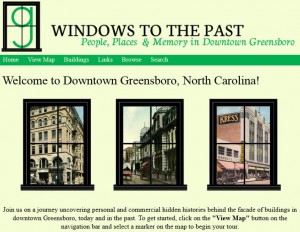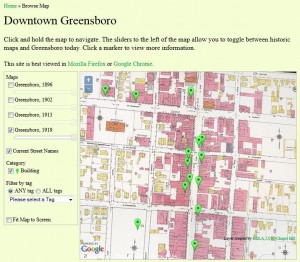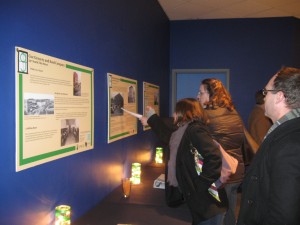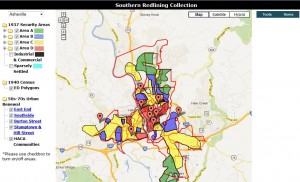The Digital Innovation Lab and the Institute for the Arts and Humanities are pleased to announce the first recipients of the new DIL/IAH Faculty Fellowship in Digital Humanities: Renee Alexander Craft, Assistant Professor of Communication Studies, and Tessa Joseph-Nicholas, Lecturer and Director of Digital Arts and Humanities Projects in the Department of Computer Science.
Part of the Carolina Digital Humanities Initiative, the fellowships allow outstanding faculty at all ranks to explore the possibilities of digital humanities for extending their research, teaching, and engagement with humanities audiences beyond the university. These new fellowships will encourage research at the intersection of traditional and engaged scholarship, the effective use of digital technologies in research and teaching, and interdisciplinary collaboration.
Craft and Joseph-Nicholas will work with the DIL to complete and launch a digital humanities project by December 2013. They will be able to access Lab resources, and will each receive a modest digital project fund.
Renee Alexander Craft: Portobelo Digital Oral History Project

“I am ecstatic to work closely with the DIL and IAH as my team and I prepare to launch a beta version of the Portobelo Digital Oral History Project.”
An Assistant Professor in the Department of Communication Studies and the Curriculum in Global Studies, Renee holds a PhD in Performance Studies from Northwestern University. She earned a MA in Communication Studies and a BA in English, both from UNC-Chapel Hill.
Her research analyzes dialectical constructions of “blackness” and performances of black cultural nationalisms in the Americas. Her work is centered on an Afro-Latin community located in the small coastal town of Portobelo, Panama who call themselves and their performance tradition “Congo.” Enacted through embodied storytelling, costumed dancing, singing, and drumming, the tradition honors the history of the cimarrones, runaway enslaved Africans who fought for and won their freedom during the Spanish colonial period. The main drama of the tradition takes place during carnival season, which peaks on the Tuesday and Wednesday before the beginning of Lent. She is currently completing two manuscript projects. The first is an ethnographic monograph entitled When the Devil Knocks: The Congo Tradition and the Politics of Blackness in 20th Century Panama. The second, My Father is a Country, is a novel based in part on her field research. Both projects engage the Congo tradition through fluctuating discourses of race, culture, and nationalism in Panama’s first century as a republic. Renee was recently on WUNC’s The State of Things; you can listen to the interview here.

Renee’s team includes Andrew Synowiez (technical lead); Rachel Cotterman (K-12 curriculum design); and Lindsay Foster Thomas of WUNC (design and creation of a Portebelo studio).
Her project, The Portobelo Digital Oral History Project, is a cultural preservation and collaborative research initiative focused on Portobelo’s Congo tradition. It responds to a call from the community for greater cultural preservation, and addresses a need from researchers to have a better platform to share and expand upon existing research. As a collaborative interdisciplinary digital humanities initiative, it seeks to make the process and products of research more available and accessible beyond the academy—especially to the communities represented by and invested in them.
The larger goals of Renee’s project will extend beyond establishing a digital space for researchers to return the stories and interviews they have collected to the population most intimately connected with them. This project will foster a collaborative digital environment in which community members and researchers may share information, correct absences and errors, and create on-going dialogues related to Congo traditions and culture. Ultimately, this project, which will likely be built with diPH, will serve as a mechanism for local community members to archive and share their cultural practices and memories.
“The opportunity to learn about and test appropriate digital tools for this project in a reflexive, interdisciplinary community, especially at this early stage, is a gift,” Renee says. “I look forward to the incubator moment that the fellowship provides to blend my current performance-centered research and pedagogy with tools and methods in the digital humanities to see what possibilities develop. It is empowering to step into this new arena with such solid support.”
Tessa Joseph-Nicholas: IVI (Inquire, Visualize, Interact): Collaborative Course Development for the Humanities
Tessa is a Lecturer and Director of Digital Arts and Humanities Projects in UNC’s Department of Computer Science. Tessa holds a MA and PhD in English and Comparative Literature from UNC, and a MFA in Creative Writing from Cornell University. She did her undergraduate work in English Literature and Creative Writing at Hobart and William Smith Colleges in Geneva, NY.

“It is an honor to be among the first generation of DIL/IAH fellows, and I look forward to a productive year.”
Tessa’s past research has focused on digital literature, e-poetries, and the function of online communities and forums in the development and promotion of movements in avant-garde or experimental poetry and poetics. Currently, she is conducting research into best practices in digital humanities instruction and instructional technologies. She is interested in the development of the digital humanities community and in working through the relationship between many DH scholars’ inquiries into human beings in the digital age and the digital tools and methods they use to conduct and present their research. She is currently developing curricula that use creative, accessible, free digital tools like App Inventor and Unity 3D to teach programming concepts to humanities students.
As Tessa explains, “The DIL/IAH fellowship will allow me to synthesize my investigations into instructional technology, digital literacies and pedagogies, and the way online communities are formed and sustained into an application that I hope will both offer a useful, practical service and help clarify the potential of text mining and visualization in learning and scholarship in the humanities.” Tessa recently presented in the “Caucus: Digital Humanities: Digital Shorts: New Platforms of Knowledge Production and Resistance” at the American Studies Association Annual Meeting in San Juan, Puerto Rico.
The IVI (Inquire, Visualize, Interact) project will design and develop a suite of simple digital humanities-inspired tools that utilize text mining, data visualizations, and social tools to enhance the functionality of existing course and content management systems (CMSs). Two linked tools will comprise IVI’s initial design: a graphical, unit-based course creation and scheduling tool that enables student and instructor inputs and a data mining and visualization tool that draws on the Syllabus Finder database, the Internet Archive, and the Common Crawl tool and corpus to produce within-system and broad visualizations of syllabus and course content data and connections between courses and syllabi on the system. IVI will be designed for initial implementation in Sakai, with an eye to wider CMS and standalone adoption.
Tessa’s project seeks to transform static, hierarchical learning management systems into innovative and interactive spaces of exploration. Course development on IVI will emerge flexibly: instructors will design sequenced units—arranged chronologically, thematically, or based on other criteria—while students will be empowered to comment on, contribute to, and investigate their instructors’ suggestions. The application will provide links to syllabi of interest from the corpus; these links can be saved in the users’ profiles and made public. On-demand data visualizations can be used to analyze within-system and general patterns of usage, language, and interest in syllabus and course content; to reveal unexpected connections between courses; and to suggest related topics and readings.
“Digital humanities projects are exciting because, among other things, they invite humanities scholars to take part in the collaborative, synthetic, project-based methodologies that are common to many of the sciences and in software development,” Tessa recently reflected. “Such collaborations have the potential to influence, even transform, the way research in the humanities is conducted, presented, and valued.”
Next Steps
These projects represent two important approaches in the Digital Humanities. Renee’s project is a cultural preservation and access project which seeks to connect researchers and community through digital technologies. With a strong public engagement component, this project provides the community with the training and tools for recording and preserving their own oral history/tradition. Tessa’s project, in contrast, seeks to build a tool for harnessing big data for pedagogic purposes. Hers is a highly computational project aimed at facilitating connection-making and analysis across very large data sets. Together, these two projects encapsulate the DIL’s and CDHI’s broader goals of creating digital humanities as public goods, as well as finding ways of processing and using big humanities data.
Work will begin in the spring semester, as the Fellows coordinate with the DIL to lay the groundwork for their projects, including finalizing the scope and scale; determining a project budget; and acquiring the requisite skills, training, and staff to complete each project. The fellows will be relieved of all teaching duties in the Fall 2013 semester in order to complete their projects. At the same time, they will serve as IAH Fellows, participating in an interdisciplinary intellectual community with the other IAH Faculty Fellows.
Renee and Tessa will blog about their experiences as the inaugural DIL/IAH Faculty Fellows. Stay tuned to learn how you can follow their progress!








